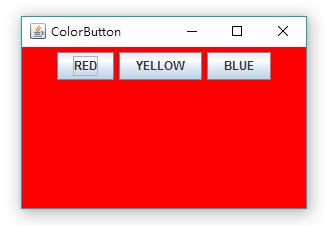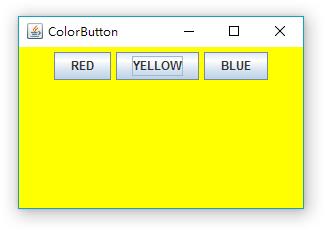GUI之 事件处理基础
- 高洛峰原创
- 2016-10-20 10:38:181796浏览
事件处理可以简单地这么理解,当有一个事件产生,程序要根据这个事件做出响应。比如,我们做了一个可以通过按钮改变背景颜色的窗口,当我们点击按钮时便产生了一个事件,程序会根据这个事件来做出响应,也就是去改变背景的颜色。
那么程序是怎样做出响应的呢?这就需要事件监听器ActionListener,这是一个接口,里面包含了actionPerformed方法(也就是根据事件去执行的操作),所以我们要实现这个接口(实现接口里的actionPerformed方法)做出一个监听器对象出来,并且用按钮来注册这个监听器对象,这样当按钮被点击的时候,就会调用这个监听器来执行响应了。



运行结果
代码(第42行开始为实现接口):
package buttonPanel;
import java.awt.*;
import java.awt.event.*; //事件监听器接口ActionListener的位置。
import javax.swing.*;
public class ButtonFrame extends JFrame {
private ButtonPanel buttonPanel;
private static final int DEFAULT_WIDTH = 300;
private static final int DEFAULT_HEIGHT = 200;
public ButtonFrame() {
setSize(DEFAULT_WIDTH,DEFAULT_HEIGHT);
setLocationByPlatform(true);
//构造按钮
JButton redButton = new JButton("RED");
JButton yellowButton = new JButton("YELLOW");
JButton blueButton = new JButton("BLUE");
buttonPanel = new ButtonPanel();
//添加按钮到面板
buttonPanel.add(redButton);
buttonPanel.add(yellowButton);
buttonPanel.add(blueButton);
add(buttonPanel);
//构造对应颜色的动作监听器
ColorAction redAction = new ColorAction(Color.red);
ColorAction yellowAction = new ColorAction(Color.yellow);
ColorAction blueAction = new ColorAction(Color.blue);
//每个按钮注册对应的监听器
redButton.addActionListener(redAction);
yellowButton.addActionListener(yellowAction);
blueButton.addActionListener(blueAction);
}
//为了方便调用buttonPanel,将ColorAction作为ButtonFrame的内部类。
private class ColorAction implements ActionListener {
private Color backgroundColor;
public ColorAction(Color c) {
backgroundColor = c;
}
public void actionPerformed(ActionEvent event) {
buttonPanel.setBackground(backgroundColor);
}
}
public static void main(String[] args) {
EventQueue.invokeLater(new Runnable() {
public void run() {
JFrame frame = new ButtonFrame();
frame.setTitle("ColorButton");
frame.setDefaultCloseOperation(EXIT_ON_CLOSE);
frame.setVisible(true);
}
});
}
}
class ButtonPanel extends JPanel {
private static final int DEFAUT_WIDTH = 300;
private static final int DEFAUT_HEIGHT = 200;
@Override
protected void paintComponent(Graphics g) {
g.create();
super.paintComponent(g);
}
@Override
public Dimension getPreferredSize() {
return new Dimension(DEFAUT_WIDTH,DEFAUT_HEIGHT);
}
}在上述代码中,为了方便监听器调用buttonPanel,将ColorAction作为ButtonFrame的内部类。如果将ColorAction类独立出去,需要将buttonPanel传递到ColorAction,实现如下:
package buttonPanel2;
import java.awt.*;
import java.awt.event.*;
import javax.swing.*;
public class ButtonFrame2 extends JFrame {
private ButtonPanel buttonPanel;
private static final int DEFAULT_WIDTH = 300;
private static final int DEFAULT_HEIGHT = 200;
public ButtonFrame2() {
setSize(DEFAULT_WIDTH,DEFAULT_HEIGHT);
setLocationByPlatform(true);
JButton redButton = new JButton("RED");
JButton yellowButton = new JButton("YELLOW");
JButton blueButton = new JButton("BLUE");
buttonPanel = new ButtonPanel();
buttonPanel.add(redButton);
buttonPanel.add(yellowButton);
buttonPanel.add(blueButton);
add(buttonPanel);
//将此对象通过this传到ColorAction的构造器。
ColorAction redAction = new ColorAction(this,Color.red);
ColorAction yellowAction = new ColorAction(this,Color.yellow);
ColorAction blueAction = new ColorAction(this,Color.blue);
redButton.addActionListener(redAction);
yellowButton.addActionListener(yellowAction);
blueButton.addActionListener(blueAction);
}
public void setButtonPanelsBackground(Color backgroundColor) {
buttonPanel.setBackground(backgroundColor);
}
public static void main(String[] args) {
EventQueue.invokeLater(new Runnable() {
public void run() {
JFrame frame = new ButtonFrame2();
frame.setTitle("ColorButton");
frame.setDefaultCloseOperation(EXIT_ON_CLOSE);
frame.setVisible(true);
}
});
}
}
class ColorAction implements ActionListener {
private ButtonFrame2 buttonFrame;
private Color backgroundColor;
//通过构造器的方法把ButtonFrame2对象传过来,这个对象包含了成员变量buttonPanel,以便对其更换背景色。
public ColorAction(ButtonFrame2 buttonFrame,Color c) {
this.buttonFrame = buttonFrame; //this.buttonFrame只是对象管理者,管理的还是ButtonFrame的对象frame。
backgroundColor = c;
}
public void actionPerformed(ActionEvent event) {
buttonFrame.setButtonPanelsBackground(backgroundColor);
//这是我们在ButtonFrame2中添加的新方法。
}
}
class ButtonPanel extends JPanel {
private static final int DEFAUT_WIDTH = 300;
private static final int DEFAUT_HEIGHT = 200;
public ButtonPanel() {
setBackground(Color.pink);
}
@Override
protected void paintComponent(Graphics g) {
g.create();
super.paintComponent(g);
}
@Override
public Dimension getPreferredSize() {
return new Dimension(DEFAUT_WIDTH,DEFAUT_HEIGHT);
}
}
ButtonFrame2代码存在一个缺陷,就是在构造按钮、添加按钮到面板、构造相应颜色的监听器和注册监听器的时候有代码复制的情况,为了避免代码复制,我们可以创建一个makeButton方法,把这些重复的操作包含在内,实现如下:
package buttonPanel3;
import java.awt.*;
import java.awt.event.*;
import javax.swing.*;
public class ButtonFrame3 extends JFrame {
private ButtonPanel buttonPanel;
private static final int DEFAULT_WIDTH = 300;
private static final int DEFAULT_HEIGHT = 200;
public ButtonFrame3() {
setSize(DEFAULT_WIDTH,DEFAULT_HEIGHT);
setLocationByPlatform(true);
buttonPanel = new ButtonPanel();
add(buttonPanel);
makeButton("RED",Color.red);
makeButton("YELLOW",Color.yellow);
makeButton("BLUE",Color.blue);
}
//为了避免代码重复,我们将重复的操作放在这个函数里。
public void makeButton(String name,final Color bg) {
JButton button = new JButton(name);
buttonPanel.add(button);
button.addActionListener(new ActionListener() { //可以new一个接口出来,但是后面必须接花括号实现内部方法。
public void actionPerformed(ActionEvent event) {
buttonPanel.setBackground(bg);
}
});
}
public static void main(String[] args) {
EventQueue.invokeLater(new Runnable() {
public void run() {
JFrame frame = new ButtonFrame3();
frame.setTitle("ColorButton");
frame.setDefaultCloseOperation(EXIT_ON_CLOSE);
frame.setVisible(true);
}
});
}
}
class ButtonPanel extends JPanel {
private static final int DEFAUT_WIDTH = 300;
private static final int DEFAUT_HEIGHT = 200;
@Override
protected void paintComponent(Graphics g) {
g.create();
super.paintComponent(g);
}
@Override
public Dimension getPreferredSize() {
return new Dimension(DEFAUT_WIDTH,DEFAUT_HEIGHT);
}
}
ButtonFrame3在代码中,监听器只被调用了一次,也就是在addActionListener()时。所以我们没有必要为监听器单独做一个类出来,而是只需在用到监听器时直接new一个ActionListener接口出来,并在花括号里实现接口方法即可。
声明:
本文内容由网友自发贡献,版权归原作者所有,本站不承担相应法律责任。如您发现有涉嫌抄袭侵权的内容,请联系admin@php.cn
上一篇:JAVA中的for-each循环与迭代下一篇:Java内存以及GC

